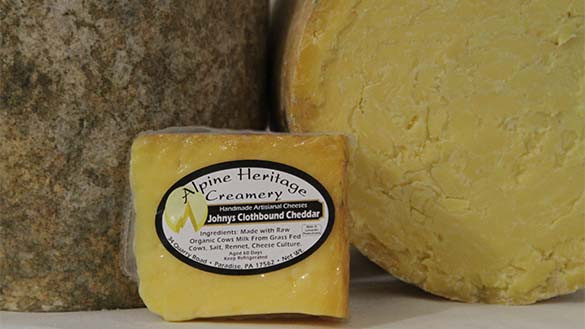Where and how the A2 cheese is made
posted on
January 31, 2020

I was honored to visit our artisanal cheesemaker - Alpine Heritage Creamery - in December. This is where farmer Aaron sends his milk to be made into cheese. I got a tour of the facilities and had a long conversation with one of the employees.
I love learning about where and how my food is made, and I know you do, too. So here’s the scoop on the cheese and the cheesemaker.
Alpine Heritage Creamery was established in 2012, following in the footsteps of 10-20 generations of cheesemakers. The owners’ forefeathers were cheesemakers in the Swiss Alps, and that’s where the name comes from.
They are a small operation. Conveniently, they’re located underneath one of our favorite meat processors - Belmont Meats. They’re in the basement and have a cheese cave underneath.
Alpine makes cheese the old-fashioned way. They don’t use any tricks or additives or extra processing. All of the cheese they make is made with raw grass-fed milk. It’s a time honored tradition and their specialty.
When you make cheese, the first thing you need to do is culture it with a specific lactic acid bacteria for cheddar, Swiss, colby, etc.
The bacteria breaks down lactose (the sugar in milk) in the absence of oxygen and creates lactic acid. With raw milk cheese, the naturally occurring bacteria and enzymes also play a role in the fermentation process. Alpine pays great attention to time, temperature, and pH, which is essential in making a great cheese.
Next, rennet is added. Rennet causes the milk to curdle so the curds (milk solids, proteins, fats, etc) can be separated from the whey (mostly water).
Rennet contains enzymes that modify the proteins in milk. It turns a common protein in milk called casseinogen into casein. This resulting curd (casein gel) also captures the fat and calcium in milk.
Alpine uses a beef rennet, derived from the lining of a cow’s stomach. Cows are not slaughtered just for the rennet. The rennet is a byproduct of slaughtering cows. It’s another way we can use and respect the whole animal.
Once separated, the cheese is pressed overnight in stainless steel containers with the appropriate pressures.
The higher the pressure, the more whey drains out, and the more firm the cheese.
It’s fair to say that one gallon of milk (about 8.5 lbs) will make about 1.25 lbs of cheese. The weight lost is the water in the milk.
Then, the cheese is wrapped and put in a cooler for aging (also known as ripening), which improves the taste and consistency.
During aging, the bacteria and enzymes continue to modify the proteins, fats, and sugar in the cheese. The longer the cheese is aged, the stronger the flavor.
Most of our cheeses are aged for 3-6 months. Mild cheddar is aged for 3-6 months. Sharp cheddar is aged for 12 months or more.
If wrapped in an airtight covering like wax or plastic, you get a moist cheese like cheddar or gouda. If wrapped in cloth, you get a dry cheese like Parmesan or clothbound cheddar.
And, fun fact! Certain strains of bacteria create carbon dioxide during the aging process. This is why certain cheese like Swiss or Emmentaler have holes.
After it’s aged, the cheese is cut to size and packaged for sale.
I watched this happening through a glass window while I was there. The employee was wearing protective layers on his head, hands, and feet!
As with any raw product, raw cheesemaking results may vary from batch to batch. However, since Alpine is so clean and consistent with their process, we tend to get fairly consistent results and delicious cheese.
If you’d like to see it for yourself, you can watch a video of how the cheesemaker makes the cheese here: https://vimeo.com/135898479
Our raw A2 cheese is one of our best selling products, and we are so happy and proud to be able to provide it to you.
What do you think of our cheese? We’d love to hear your feedback. And, as always, let me know if you have any questions!




